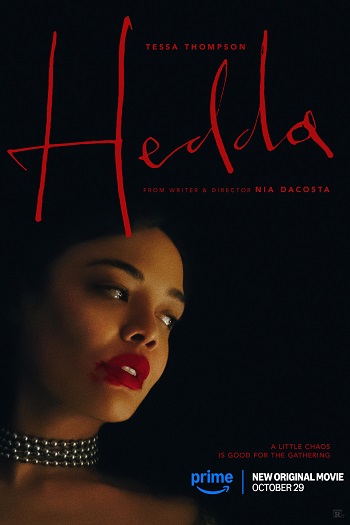Watch Online Heddar (2025) Full Movie In Hindi Dubbed And English Web-DL.Heddar Hindi – English DD5.1 1080p 720P 480p HEVC HDRip Dual Audio Drama 300MB Movies Via One Click Direct High Speed Links
Heddar 2025 Hindi Dubbed ORG Dual Audio 1080p 720p 480p Web-DL
IMDB Ratings: 6.5/10
Directed: Nia DaCosta
Released Date: October 22, 2025
Genres: Drama
Languages: Hindi, English
Film Stars: Thompson, Nina Hoss, Imogen Poots
Movie Quality: 1080p 720p 480p Web-DL
File Size: 1.9GB, 1GB , 375MB , MB
Story: Henrik Ibsen’s renowned stage drama from 1891 is reimagined in an epic and emotional way.
Heddar (2025) Full Movie Hindi Dual-Audio [Hindi & English] HD
|| 480p Links ||
|| 720p Links ||
|| 1080p Links ||
|| Heddar 2025 Hindi Dubbed Movie Reviews Online ||
That's a great request! Nia DaCosta's 2025 film, Hedda, is a visually stunning and thematically audacious reinterpretation of Henrik Ibsen's 1891 play, Hedda Gabler.
Here is a detailed analysis of the adaptation, its performances, and its aesthetic design.
Detailed Analysis of Nia DaCosta’s Hedda
1. Thematic Adaptation and Modernization
DaCosta’s Hedda is not a simple transposition but a radical re-contextualization, shifting the action from late 19th-century Norway to a lavish, psychologically claustrophobic English country estate in the 1950s. The story is condensed into a single, hedonistic, and volatile night—a sprawling party thrown by the newly married Hedda.
Race and Agency: A crucial modern element is casting Tessa Thompson as Hedda, a mixed-race woman born into a privileged but stifling upper-class world. While the film avoids grand speeches on racial hardship, Hedda’s position is perpetually questioned within her circle, adding layers of complexity to her anti-heroic "monstrousness." DaCosta has explicitly stated her interest in depicting complex Black women "behaving badly," challenging the expectation that they must serve as virtuous role models. Hedda’s manipulative actions are thus framed not just by general female repression, but by the specific intersectional pressures of her identity in a mid-century, post-war English society.
Queer Sexuality: The film makes the subtext of the original play overt by gender-swapping the character of Eilert Løvborg to Eileen Lovborg (played by Nina Hoss). Eileen is Hedda’s brilliant, passionate former lover and her husband George Tesman’s main academic rival. This change injects a visceral, queer jealousy into the central conflict. Hedda's manipulation of Eileen—which includes pushing her toward relapse and ultimate destruction—is driven by a volatile mix of romantic regret, lingering desire, and ruthless ambition to protect her own security, making the film a profound study of how external societal constraints (heteronormativity, sexism) force women to suppress their true selves.
The Gilded Cage: The core thematic struggle remains Hedda's alienation and her desperate fight for agency. She finds herself trapped in a marriage that promised luxury but delivered only debt and boredom. The action of the film is essentially a long game of chess where Hedda uses her guests as "playthings" to alleviate her desperation and carve out a sense of self-control.
2. The Performance Dynamic: Thompson vs. Hoss
The film’s critical consensus centers on the electric, yet complicated, duet between the two lead actresses.
Tessa Thompson's Hedda: Thompson embodies Hedda as a meticulously stylized, whip-smart, and dangerously charismatic social manipulator. Critics note her "aggressively fluted and mannered" British accent and calculated performance, which conveys a sense that Hedda is constantly acting out a fiction of herself to maintain control. Thompson’s Hedda is a magnet for attention—sultry, machiavellian, and an agent of chaos—but this highly stylized approach sometimes leaves the character's internal vulnerability opaque, prioritizing an "attitude" over a fully realized emotional core.
Nina Hoss's Eileen Lovborg: In contrast to Thompson's artifice, Nina Hoss's performance is widely praised as the emotional apex of the film. Hoss imbues Eileen with palpable vulnerability, passion, and tragic fragility. Her character, having chosen to live more openly as a female academic and lesbian, represents the freedom Hedda sacrificed for security. The tension between the two is palpable; they "circle one another like hungry panthers," their past erotic bond still crackling in the air. Eileen's descent, orchestrated by Hedda's cruel machinations, is rendered by Hoss as a subtle, devastating portrait of relapse and betrayal, giving the film an emotional grounding that some critics feel Thompson's highly guarded Hedda sometimes lacks.
3. Aesthetic and Directional Choices
DaCosta leverages cinematic language to mirror Hedda's psychological state.
Production Design and Symbolism: The production design, led by Cara Bower, is a masterclass in controlled opulence. The interiors of the Tesman estate are a "gilded cage," featuring ornate wallpapers in rich jewel tones (like the peacock motif) that seem to physically press inward, reflecting Hedda's suffocating repression. This interior claustrophobia is deliberately contrasted with the exterior freedom of the lake and sprawling English landscape, which beckons Hedda as a form of "existential resolution."
Cinematography (Sean Bobbitt): Cinematographer Sean Bobbitt gives the film a high-end, elegant look, evoking a mid-century noir sensibility. One of the film's most notable technical flourishes is the double dolly shot used for Eileen’s dramatic arrival. This shot, which makes Hedda appear to float across the room, visually signals the rare moment where she loses her composure and control, fixated on her former lover.
Pacing and Form: DaCosta’s direction is meticulous, often utilizing deliberate blocking and static medium shots, which contributes to the film’s "staginess." While this intentional confinement forces the audience to experience Hedda's entrapment, some reviews noted that the film's pace can feel slack in the middle, allowing the narrative's momentum to dilute before the climactic final act. However, the technical elegance and the explosive lead performances hold the audience's attention throughout the film's ambitious run time.




![Lokah Chapter 1: Chandra (2025) Dual Audio [Hindi + MultiAudio] WeB-DL 4K](https://blogger.googleusercontent.com/img/b/R29vZ2xl/AVvXsEh4ln01dc75Oosm8B6vLA-k3DWK_p7n6hhFZBrerCdGfCpwOYdObP3W0QBVgtmvLz1fJEqcqVlly-NHhgUTm3psHtBnbMv7qzAnaTh_4zhXjsKsGXB68mX4DnH3WUnZ-oXIE9eT3WQJSQsHxt4Tgd7-ujlBjwCc9iL2WcZhQ1ojHcGcpdwUd0YPZBy7H9k/w680/1000124837.webp)